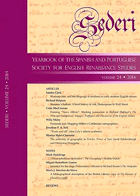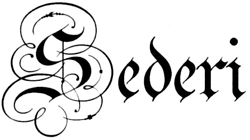
Sederi 24
Sederi 24 — 2014
EDITORS
Berta Cano Echevarría & Ana Sáez-Hidalgo
REVIEW EDITOR
Francisco J. Borge López
ISSN 1135-7789
Sandra Clark, “Women, class, and the language of madness in early modern English drama.” SEDERI 24 (2014): 7-26.
DOI: https://doi.org/10.34136/sederi.2014.1 Download PDF
Abstract
This paper discusses the depiction of madwomen in a range of early modern English plays including some by Shakespeare in order to show how their madness operates at the intersection of gender, genre, and social class. Its particular focus is on language, and it argues that the speech styles of madwomen are essentially similar whatever their social class. For women, madness is a linguistically liberating condition, bringing together high and low cultural discourses. While stage madwomen’s language has similarities with that of madmen, it is more licentious and transgressive because the violation of social and behavioural norms is more extreme.
Keywords: Madness; language; nonsense; transgression; taboo; impertinency; popular tradition; ballads; gender; liberation; imagination; sexuality.
References
Bakhtin, Mikhail 1984. Rabelais and his World. Trans. Helene Iswolsky. Bloomington: Indiana University Press.
Bright, Timothy 1586. A Treatise of Melancholie. London.
Bruster, Douglas 1995. “The Jailor’s Daughter and the Politics of Madwomen’s Language.” Shakespeare Quarterly 46/3: 277-300.
Burton, Robert 1972 (1621). The Anatomy of Melancholy. Ed. Holbrook Jackson. London: J. M. Dent and Sons.
Capp, Bernard 2004. When Gossips Meet: Women, Family, and Neighbourhood in Early Modern England. Oxford: Oxford University Press.
Chakravarti, Paromita 2008. “’I have no other but a woman’s reason’: Folly, Femininity and Sexuality in Renaissance Discourses and Shakespeare’s Plays.” The Shakespearean International Yearbook 8: 136-161.
Charney, Maurice and Hanna Charney 1977. “The Language of Madwomen in Shakespeare and his Fellow Dramatists.” Signs 3/2: 451-460.
Chettle, Henry 1951 (1631). The Tragedy of Hoffman. Ed. Harold Jenkins. Oxford: The Malone Society Reprints.
Child, Francis James 1965. The English and Scottish Popular Ballads. New York: Dover Publications.
Coddon, Karin S. 1989. “’Unreal Mockery’: Unreason and the Problem of Spectacle in Macbeth.” ELH 56/3: 485-501.
Dawson, Lesel 2008. Lovesickness and Gender in Early Modern English Literature. Oxford: Oxford University Press.
Dunn, Leslie C. 1994. “Ophelia’s Songs in Hamlet: Music, Madness and the Feminine.” Eds. Leslie C. Dunn and Nancy A Jones. Embodied Voices: Representing Female Vocality in Western Culture. Cambridge: Cambridge University Press: 50-64.
Fletcher, John 1621? The Pilgrim. Ed. Fredson Bowers. The Dramatic Works in the Beaumont and Fletcher Canon. Vol. 6. Cambridge: Cambridge University Press.
Foucault, Michel. 1971. Madness and Civilization: A History of Insanity in the Age of Reason. Trans. Richard Howard. London: Tavistock Publications.
Henslowe, Philip 1961. Henslowe’s Diary. Ed. R. A. Foakes and R. T. Rickert. Cambridge: Cambridge University Press.
Iyengar, Sujata 2011. Shakespeare’s Medical Language: A Dictionary. London-New York: Continuum.
Kyd, Thomas 1970 (1590?). The Spanish Tragedy. Ed. J. R. Mulryne. London: 1970.
Lecercle, Jean-Jacques 1990. The Violence of Language. London and New York: Routledge.
Levin, Harry 2004. “Two Scenes from Macbeth.” Macbeth. Ed. Robert S. Miola. New York and London: W. W. Norton and Company: 266-282.
MacDonald, Michael 1981. Mystical Bedlam: Madness, Anxiety and Healing in Seventeenth-century England. Cambridge: Cambridge University Press.
MacDonald, Michael 1986. “Ophelia’s Maimed Rites.” Shakespeare Quarterly 37/3: 309-317.
Marlowe, Christopher 1981 (1590?). Tamburlaine. Ed. J. S. Cunningham. Manchester: Manchester University Press.
Moore, John Robert 1916. “The Function of Songs in Shakespeare’s Plays.” Shakespeare Studies by Members of the Department of English of the University of Wisconsin. Wisconsin: University of Wisconsin Press.
Neely, Carol Thomas 2004. Distracted Subjects: Madness and Gender in Shakespeare and Early Modern Culture. Ithaca and London: Cornell University Press.
Peterson, Kaara L. 2010. “Portraying Shakespeare’s Hysterics.” Mosaic 34/1: 35-59.
Rutter, Carol, ed. 1988. Clamorous Voices: Shakespeare’s Women Today. London: The Women’s Press.
Rose, Mary Beth 1988. The Expense of Spirit: Love and Sexuality in English Renaissance Drama. Ithaca and London: Cornell University Press.
Salkeld, Duncan 1993. Madness and Drama in the Age of Shakespeare. Manchester: Manchester University Press.
Seng, Peter J. 1967. The Vocal Songs in the Plays of Shakespeare. Cambridge, MA: Harvard University Press.
Shakespeare, William 1982 (1603). Hamlet. Ed. Harold Jenkins. London and New York: Methuen.
Shakespeare, William 2006 (1603). Hamlet. Eds. Ann Thompson and Neil Taylor. London: Thomson Learning.
Shakespeare, William and John Fletcher 1997 (1613). The Two Noble Kinsmen. Ed. Lois Potter. London: Thomas Nelson and Sons Ltd.
Shirley, James 1986 (1641). The Cardinal. Ed. E. M. Yearling. Manchester: Manchester University Press.
Stallybrass, Peter and Allon White 1986. The Politics and Poetics of Transgression. London: Methuen.
Thiher, Allen 1999. Revels in Madness: Insanity in Medicine and Literature. Ann Arbor: University of Michigan Press.
Thomas, Keith 1973. Religion and the Decline of Magic. Harmondsworth: Penguin Books.
Thomas, Vivien and Nicki Faircloth 2014. A Dictionary of Plants and Gardens in Shakespeare. Arden Shakespeare Dictionaries. London: Bloomsbury.
Thorndike, Ashley, H. 1902. “The Relationship of Hamlet to Contemporary Revenge Plays.” PMLA 17/2: 125-220.
Weimann, Robert 1987. Shakespeare and the Popular Tradition in the Theater. Ed. Robert Schwartz. Baltimore and London: Johns Hopkins University Press.
Wiltenberg, Joy 1988. “Madness and Society in the Street Ballads of Early Modern England.” Journal of Popular Culture 21/4: 101-127
